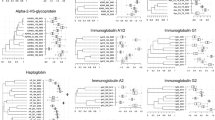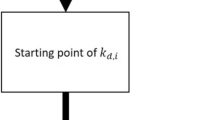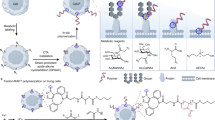Abstract
Glycopolymers consisting of mannose and acrylamide with different mannose incorporation ratios (10 and 100%) were synthesized by reversible addition fragmentation chain transfer (RAFT) polymerization, and the polymer layers were prepared on a gold substrate. The detailed polymer layer structure and molecular recognition properties were analyzed by the surface plasmon resonance (SPR) technique. The glycopolymers formed pancake-like thin layers with thicknesses of ∼2 nm in air and were swollen in the aqueous solution. The molecular recognition against concanavalin A (ConA) was also analyzed by SPR. Binding constants between glycopolymers and ConA were large enough to suggest multivalent effects. Binding rate constants of ConA to glycopolymers were in the same order; however, the dissociation rate constant was lower in the glycopolymer with a mannose ratio of 100% because of the high local mannose density near the binding point of ConA.
Similar content being viewed by others
Log in or create a free account to read this content
Gain free access to this article, as well as selected content from this journal and more on nature.com
or
References
Taylor, M. E. & Drickamer, K. Introduction to Glycobiology, (Oxford University Press, Oxford, UK, 2002).
Mandal, D. K., Kishore, N. & Brewer, C. F. Thermodynamics of lectin-carbohydrate interactions. Titration microcalorimetry measurements of the binding of N-linked carbohydrates and ovalbumin to concanavalin A. Biochemistry 33, 1149–1156 (1994).
Dam, T. K. & Brewer, C. F. Thermodynamic studies of lectin-carbohydrate interactions by isothermal titration calorimetry. Chem. Rev. 102, 387–430 (2002).
Murrey, H. E. & Hsieh-Wilson, L. C. The chemical neurobiology of carbohydrates. Chem. Rev. 108, 1708–1731 (2008).
Lee, Y. C. & Lee, R. T. Carbohydrate-protein interactions: basis of glycobiology. Acc. Chem. Res. 28, 321–327 (1995).
Mammen, M., Choi, S.-K. & Whitesides, G. M. Polyvalent interactions in biological systems: implications for design and use of multivalent ligands and inhibitors. Angew. Chem., Int. Ed. 37, 2754–2794 (1998).
Schnaar, R. L. & Lee, Y. C. Polyacrylamide gels copolymerized with active esters. New medium for affinity systems. Biochemistry 14, 1535–1541 (1975).
Miura, Y., Hoshino, Y. & Seto, H. Glycopolymer nanobiotechnology. Chem. Rev. 116, 1673–1692 (2016).
Bernard, J., Hao, X., Davis, T. P., Barner-Kowollik, C. & Stenzel, M. H. Synthesis of various glycopolymer architectures via RAFT polymerization: from block copolymers to stars. Biomacromolecules 7, 232–238 (2006).
Fernandez-Megia, E., Correa, J., Rodríguez, I. & Riguera, R. A click approach to unprotected glycodendrimers. Macromolecules 39, 2113–2120 (2006).
Ghadban, A. & Albertin, L. Synthesis of glycopolymer architectures by reversible-deactivation radical polymerization. Polymers 5, 431–526 (2013).
Chen, Y., Espeel, P., Reinicke, S., Du Prez, F. E. & Stenzel, M. H. Control of glycopolymer nanoparticle morphology by a one-pot, double modification procedure using thiolactones. Macromol. Rapid Commun. 35, 1128–1134 (2014).
Ting, S. R. S., Chen, G. & Stenzel, M. H. Synthesis of glycopolymers and their multivalent recognitions with lectins. Polym. Chem. 1, 1392–1412 (2010).
Zhang, Q., Collins, J., Anastasaki, A., Wallis, R., Mitchell, D. A., Becer, C. R. & Haddleton, D. M. Sequence-controlled multi-block glycopolymers to inhibit DC-SIGN-gp120 binding. Angew. Chem. 52, 4435–4439 (2013).
Gou, Y., Geng, J., Richards, S.-J., Burns, J., Becer, C. R. & Haddleton, D. M. A detailed study on understanding glycopolymer library and ConA interactions. J. Polym. Sci. A Polym. Chem. 51, 2588–2597 (2013).
Yilmaz, G. & Becer, C. R. Precision glycopolymers and their interactions with lectins. Eur. Polym. J. 49, 3046–3051 (2013).
Yang, Q., Xu, Z.-K., Dai, Z.-W., Wang, J.-L. & Ulbricht, M. Surface modification of polypropylene microporous membranes with a novel glycopolymer. Chem. Mater. 17, 3050–3058 (2005).
Mateescu, A., Ye, J., Narain, R. & Vamvasaki, M. Synthesis and characterization of novel glycosurfaces by ATRP. Soft Matter 5, 1621–1629 (2009).
Yang, Q., Kaul, C. & Ulbricht, M. Anti-nonspecific protein adsorption properties of biomimetic glycocalyx-like glycopolymer layers: effects of glycopolymer chain density and protein size. Langmuir 26, 5746–5752 (2010).
Park, H., Rosencrantz, R. R., Elling, L. & Böker, A. Glycopolymer brushes for specific lectin binding by controlled multivalent presentation of N-acetyllactosamine glycan oligomers. Macromol. Rapid Commun. 36, 45–54 (2015).
Wu, T., Efimenko, K. & Genzer, J. Combinatorial study of the mushroom-to-brush crossover in surface anchored polyacrylamide. J. Am. Chem. Soc. 124, 9394–9395 (2002).
Balamurugan, S., Mendez, S., Balamurugan, S. S., O’Brien, M. J. II & López, G. P. Thermal response of poly(N-isopropylacrylamide) brushes probed by surface plasmon resonance. Langmuir 19, 2545–2549 (2003).
Gunkel, G., Weinhart, M., Becherer, T., Haag, R. & Huck, W. T. S. Effect of polymer brush architecture on antibiofouling properties. Biomacromolecules 12, 4169–4172 (2011).
Bousquet, A., Awada, H., Hiorns, R. C., Dagron-Lartigau, C. & Billon, L. Conjugated-polymer grafting on inorganic and organic substrates: a new trend in organic electronic materials. Prog. Polym. Sci. 39, 1847–1877 (2014).
Stuart, M. A. C., Huck, W. T., Genzer, J., Müller, M., Ober, C., Stamm, M., Sukhorukov, G. B., Szleifer, I., Tsukruk, V. V. & Urban, M. Emerging applications of stimuli-responsive polymer materials. Nat. Mater. 9, 101–113 (2010).
Lee, B. S., Chi, Y. S., Lee, K.-B., Kim, Y.-G. & Choi, I. S. Functionalization of poly(oligo(ethylene glycol) methacrylate) films on gold and Si/SiO2 for immobilization of proteins and cells: SPR and QCM studies. Biomacromolecules 8, 3922–3929 (2007).
Kambhampati, D. K., Jakob, T. A., Robertson, J. W., Cai, M., Pemberton, J. E. & Knoll, W. Novel silicon dioxide sol-gel films for potential sensor applications: a surface plasmon resonance study. Langmuir 17, 1169–1175 (2001).
Liedberg, B., Nylander, C. & Lundström, I. Surface plasmon resonance for gas detection and biosensing. Sensors Actuat. 4, 299–304 (1983).
Mrksich, M., Sigal, G. B. & Whitesides, G. M. Surface plasmon resonance permits in situ measurement of protein adsorption on self-assembled monolayers of alkanethiolates on gold. Langmuir 11, 4383–4385 (1995).
Lee, H. J., Goodrich, T. T. & Corn, R. M. SPR imaging measurements of 1-D and 2-D DNA microarrays from microfluidic channels on gold thin films. Anal. Chem. 73, 5525–5531 (2001).
Bassil, N., Maillart, E., Canva, M., Lévy, Y., Millot, M.-C., Pissard, S., Narwa, R. & Goosens, M. One hundred spots parallel monitoring of DNA interactions by SPR imaging of polymer-functionalized surface applied to the detection of cystic fibrosis mutations. Sensors Actuat. B 94, 313–323 (2003).
Wolf, L. K., Fullenkamp, D. E. & Georgiadis, R. M. Quantitative angle-resolved SPR imaging of DNA-DNA and DNA-drug kinetics. J. Am. Chem. Soc. 127, 17453–17459 (2005).
Takara, M., Toyoshima, M., Seto, H., Hoshino, Y. & Miura, Y. Polymer-modified gold nanoparticles via RAFT polymerization: a detailed study for a biosensing application. Polym. Chem. 5, 931–939 (2014).
Toyoshima, M., Oura, T., Fukuda, T., Matsumoto, E. & Miura, Y. Biological specific recognition of glycopolymer-modified interfaces by RAFT living radical polymerization. Polym. J. 42, 172–178 (2010).
Terada, Y., Hashimoto, W., Endo, T., Seto, H., Murakami, T., Hisamoto, H., Hoshino, Y. & Miura, Y. Signal amplified two-dimensional photonic crystal biosensor immobilized with glycol-nanoparticles. J. Mater. Chem. B 2, 3324–3332 (2014).
Seto, H., Takara, M., Yamashita, C., Murakami, T., Hasegawa, T., Hoshino, Y. & Miura, Y. Surface modification of siliceous materials using maleimidation and various functional polymers synthesized by reversible addition-fragmentation chain transfer polymerization. ACS Appl. Mater. Interfaces 4, 5125–5133 (2012).
Kretschmann, E. & Raether, H. Z. Notizen: radiative decay of non radiative surface plasmons excited by light. Z. Naturforsch. A 23, 2135–2136 (1968).
Jordan, C. E. & Corn, R. M. Surface plasmon resonance imaging measurements of electrostatic biopolymer adsorption onto chemically modified gold surfaces. Anal. Chem. 69, 1449–1456 (1997).
Bramblett, A. L., Boeckl, M. S., Hauch, K. D., Ratner, B. D., Sasaki, T. & Rogers, J. Determination of surface coverage for tetraphenylporphyrin monolayers using ultraviolet visible absorption and x-ray photoelectron spectroscopies. Surf. Interface Anal. 33, 506–515 (2002).
Yokota, Y., Miyazaki, A., Fukui, K.-I., Enoki, T., Tamada, K. & Hara, M. Dynamic and collective electrochemical responses of tetrathiafulvalene derivative self-assembled monolayers. J. Phys. Chem. B 110, 20401–20408 (2006).
Tamada, K., Ishida, T., Knoll, W., Fukushima, H., Colorado, R. Jr, Graupe, M., Shmakova, O. E. & Lee, T. R. Molecular packing of semifluorinated alkanethiol self-assembled monolayers on gold: influence of alkyl spacer length. Langmuir 17, 1913–1921 (2001).
Franklin, J. & Wang, Z. Y. Refractive index matching: a general method for enhancing the optical clarity of a hydrogel matrix. Chem. Mater. 14, 4487–4489 (2002).
Rubinstein, M. Polymer Physics, (Oxford Univ. Press, NY, 2003).
Advincula, R. C., Brittain, W. J., Caster, K. C. & Rühe, J. Polymer Brushes, (WILEY-VCH Verlag GmbH & Co. KGaA, Weinheim ISBN, 2004).
Jack, A., Weinzierl, J. & Kalb, A. J. An X-ray crystallographic study of demetallized concanavalin A. J. Mol. Biol. 58, 389–395 (1971).
Mori, T., Toyoda, M., Ohtsuka, T. & Okahata, Y. Kinetic analyses for bindings of concanavalin A to dispersed and condensed mannose surfaces on a quartz crystal microbalance. Anal. Biochem. 395, 211–216 (2009).
Loris, R., Maes, D., Poortmans, F., Wyns, L. & Bouckaert, J. A structure of the complex between concanavalin A and methyl-3,6-di-O-(alpha-D-mannopyranosyl)-alpha-D-mannopyranoside reveals two binding modes. J. Biol. Chem. 271, 30614–30618 (1996).
Acknowledgements
The MALS measurements and discussion were supported by Professor Atushi Maruyama and Dr Naohiko Shimada (Tokyo Institute of Technology). This work was supported by a Grant-in-Aid for Scientific Research B (15H03818), a Grant-in-Aid for Exploratory Research (16K14007) and a Grant-in-Aid for Scientific Research on Innovative Areas (16H01036).
Author information
Authors and Affiliations
Corresponding author
Ethics declarations
Competing interests
These authors declare no conflict of interest.
Additional information
Supplementary Information accompanies the paper on Polymer Journal website
Supplementary information
Rights and permissions
About this article
Cite this article
Terada, Y., Seto, H., Hoshino, Y. et al. SPR study for analysis of a water-soluble glycopolymer interface and molecular recognition properties. Polym J 49, 255–262 (2017). https://doi.org/10.1038/pj.2016.99
Received:
Revised:
Accepted:
Published:
Issue date:
DOI: https://doi.org/10.1038/pj.2016.99



